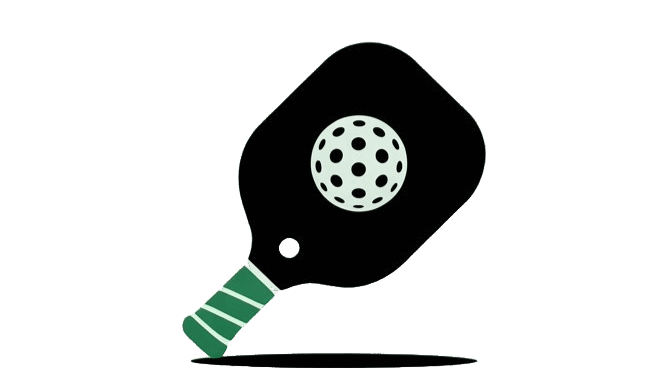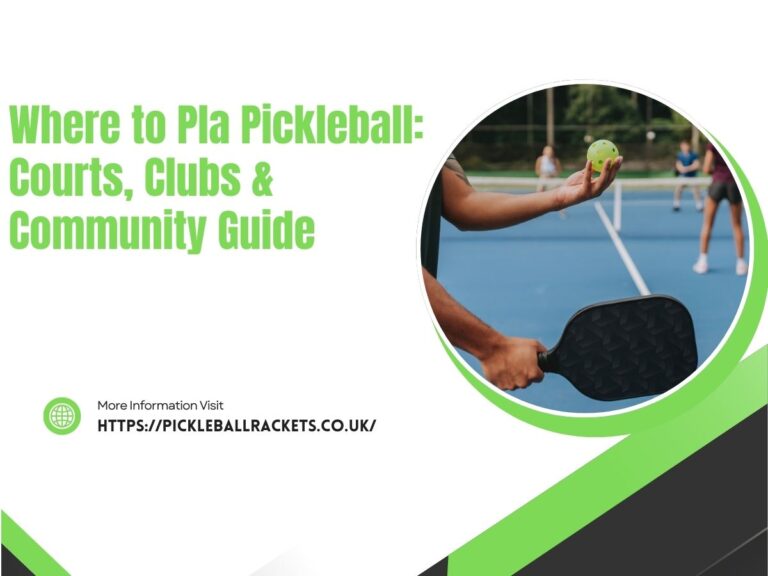Pickleball is often described as easy to learn but difficult to master. While anyone can pick up a paddle and enjoy a casual game, elevating your play from recreational to competitive requires more than just hitting the ball over the net. It demands a deep understanding of strategy, technique, and mental fortitude. Whether you’re a beginner aiming to hold your own on the court or an advanced player looking to gain a competitive edge, strategy is the great equalizer.
This comprehensive guide will explore every facet of pickleball strategy. We will break down how beginners and advanced players can approach the game differently, from fundamental drills to sophisticated doubles tactics. You will learn the nuances of serving, the art of dinking, the power of the lob, and the secrets to winning more games. This is your roadmap to not just playing pickleball, but thinking like a winner.
How to Get Better at Pickleball
Improving at pickleball is a journey that combines physical practice with a strategic mindset. Raw power might win a few points, but consistency, patience, and intelligent shot placement win matches. To truly get better, you need to focus on deliberate practice, physical conditioning, and mental toughness.
Importance of Practice & Drills
You can’t improve what you don’t practice. Simply playing games will help, but targeted drills are the fastest way to refine your skills. Drills allow you to isolate specific weaknesses and turn them into strengths through repetition.
Some of the best pickleball drills for beginners and advanced players include:
- Wall Drills: Find a solid wall and practice hitting volleys, dinks, and groundstrokes. This is an excellent way to improve hand-eye coordination and reaction time when you don’t have a partner.
- Dink Drills: Stand at the non-volley zone (NVZ) line and practice dinking cross-court and straight ahead with a partner. The goal is to hit 10, 20, or even 50 consecutive dinks without a mistake. This builds incredible patience and control.
- Third-Shot Drop Drills: Have a partner serve to you from the baseline. Practice hitting a soft, arcing third-shot drop that lands gently in their kitchen. This is one of the most crucial shots in pickleball.
- Serve and Return Drills: Dedicate time to practicing your serves for depth and accuracy. Have your partner practice returning them deep into your court, forcing you to prepare for the third shot.
Warm-Up Routines and Footwork Exercises
Arriving at the court and immediately jumping into a game is a recipe for injury and sloppy play. A proper warm-up prepares your muscles for explosive movements and gets your mind focused. Your warm-up should last at least 5-10 minutes.
Essential Warm-Up Components:
- Dynamic Stretching: Start with light jogging, jumping jacks, or high knees to increase your heart rate. Follow this with dynamic stretches like leg swings, arm circles, and torso twists.
- Mini-Pickleball: Start by dinking with your partner at the kitchen line, then gradually move back to the baseline to hit groundstrokes. This warms up your muscles for the specific movements of the game.
Pickleball footwork drills are equally important. Your feet get you into position to hit the right shot. Practice side shuffles along the kitchen line, split-stepping as your opponent hits the ball, and moving backward and forward with control. Good footwork reduces unforced errors and keeps you balanced.
Mindset: Patience, Consistency, and Shot Selection
The mental side of pickleball is just as important as the physical. Three pillars of a winning mindset are patience, consistency, and shot selection.
- Patience: Pickleball is a game of patience. Many points are won not by a blistering winner, but by waiting for your opponent to make a mistake. This is especially true during dink rallies. Resist the urge to attack a ball that is too low. Wait for a high ball you can put away.
- Consistency: The player who makes fewer unforced errors usually wins. Focus on getting the ball over the net and in play. A good, consistent shot is always better than a great shot that has a low probability of success. Aim to be a reliable wall that returns everything.
- Shot Selection: Winning strategies in pickleball revolve around making smart choices. Don’t just hit the ball; hit it with a purpose. Ask yourself: “Is this the right time for a drop, a drive, or a lob?” Your decision should be based on your court position, your opponent’s position, and the height of the ball.
Mastering the Pickleball Serve
Every point in pickleball starts with a serve. A strong, consistent serve can immediately put your opponents on the defensive and set you up for an easy third shot. While you can’t win a game with your serve alone, a poor serve can certainly lose it for you.
Basic Legal Serve Rules
Before trying advanced techniques, you must understand the rules of a legal serve. The USA Pickleball rulebook specifies three main requirements for a standard serve:
- The arm must be moving in an upward arc when the ball is struck.
- Paddle contact with the ball must not be made above the waist.
- The highest point of the paddle head must not be above the highest part of the wrist at contact.
You must also keep both feet behind the baseline during the serve and serve diagonally into the opponent’s service court.
Standard Serve Technique
The standard serve is the foundation for all other serving techniques. It prioritizes consistency and placement over power.
How to Execute a Standard Serve:
- Position: Stand a few feet behind the baseline, angled slightly toward your target.
- Grip: Use a continental grip (like holding a hammer).
- Drop: Hold the ball out in front of your paddle face. Don’t toss it up; simply drop it and let it bounce.
- Swing: As the ball drops, swing your paddle forward in a smooth, underhand motion, making contact around knee-height.
- Follow-Through: Follow through in the direction of your target. Your goal is to land the serve deep in the opponent’s service box, near the baseline. A deep serve makes their return more difficult and gives you more time to prepare for the third shot.
Spin Serve: How It Works, Is It Legal, When to Use
Spin serves can be a powerful weapon, but their legality has been a topic of debate. As of recent rule changes, you can no longer impart spin with your non-paddle hand during the serve. However, you can still generate spin with the paddle itself. This is often called a “slice” or “topspin” serve.
- How It Works: To create a slice, you “cut” under the ball with an open paddle face. For topspin, you brush up the back of the ball. This is much harder to do with an underhand motion but is still possible.
- Is It Legal? Yes, as long as you only use the paddle to create the spin and follow all other serving rules (underhand motion, contact below the waist).
- When to Use: Use a spin serve to disrupt your opponent’s timing. A good slice serve can stay low and skid, making it difficult to return cleanly. Mix it in with your standard serve to keep opponents guessing.
Lob Serve for Variation
A lob serve is a high, arcing serve intended to land deep in the service box, forcing the returner to move back and hit an off-balance shot. It’s an excellent change-of-pace serve.
When to use a lob serve:
- Against opponents with limited mobility.
- When your opponent is creeping up, expecting a standard serve.
- On a sunny or windy day to make tracking the ball more difficult.
The technique is similar to a standard serve, but you’ll use a more open paddle face and a bigger, upward swing to generate height. Be careful not to hit it too short, as that gives your opponent an easy smash.
Serving Mistakes to Avoid
- Foot Faults: Stepping on or over the baseline during your serve is a common fault.
- Serving into the Net: Often caused by not getting low enough or not following through.
- Serving Too Short: A short serve allows your opponent to hit an aggressive return and rush the net, putting you on the defensive immediately. Aim for depth every time.
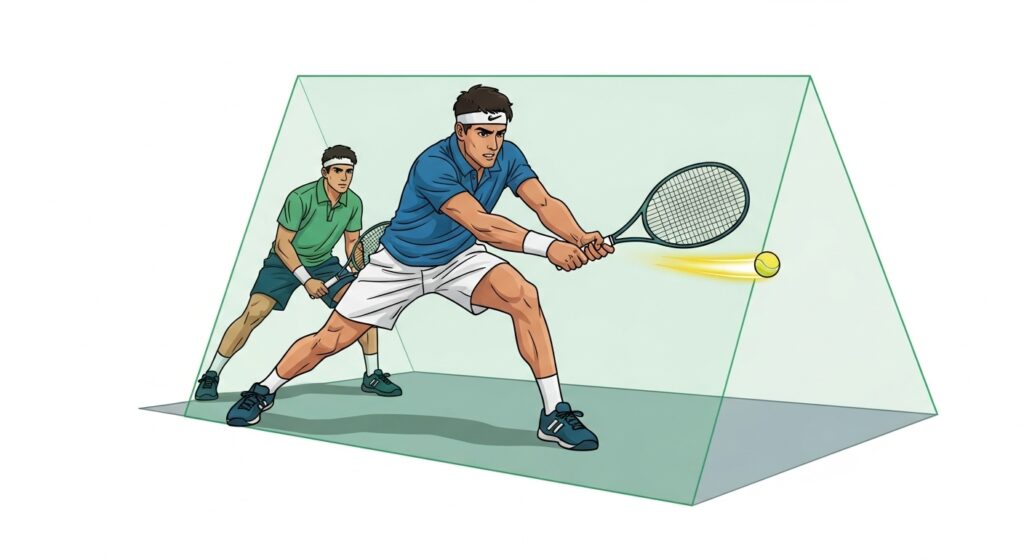
Dinking at the Kitchen
The non-volley zone, or “kitchen,” is where most points are won and lost in doubles. The primary shot in this area is the dink—a soft, un-attackable shot that arcs over the net and lands in the opponent’s kitchen. Mastering the dink is essential for any serious player.
What Is a Dink?
A dink is not a defensive shot; it’s a neutral shot designed to reset the point and prevent your opponents from attacking. The goal of a dink is to force your opponent to hit upward on the ball, which may eventually lead to them popping it up for you to put away. How to dink in pickleball is one of the first strategic questions players ask when trying to improve.
Proper Technique for Soft Shots
Dinking is about touch, not power. The motion should be compact and controlled.
- Get Low: Bend your knees and get your body low to the ground. You want to make contact with the ball in front of you.
- Soft Hands: Hold the paddle with a light grip. A tight grip leads to pop-ups.
- Shoulder Movement: The motion should come from your shoulder, not your wrist. Think of it as a gentle lift or push, with very little backswing.
- Paddle Face: Keep the paddle face slightly open and aim for the ball to peak on your side of the net, then fall into the opponent’s kitchen.
Cross-Court Dink Strategy
The safest and most effective dink is the cross-court dink. There are two reasons for this:
- More Room for Error: The diagonal distance across the kitchen is longer than the straight-ahead distance, giving you a larger target.
- Lower Net: The net is two inches lower in the center, making it easier to clear.
By dinking cross-court, you also force your opponents to move, which can create openings. Use the cross-court dink as your default shot during a kitchen rally.
Dink Rallies and Patience Drills
Dink rallies are a battle of wills. The key is to remain patient and wait for your opportunity. Don’t be the first one to try a risky speed-up. Keep dinking, move your opponents around, and wait for them to make a mistake or hit a ball high enough for you to attack.
A great drill is “Dink to 10,” where you and a partner try to sustain a dink rally for 10 successful shots. If someone makes a mistake, you start over. This drill builds the muscle memory and mental patience required for high-level kitchen play.
When to Speed Up Play at the Kitchen Line
While patience is key, you also need to recognize when to be aggressive. You should speed up the ball (hit a hard volley) when your opponent hits a dink that is too high or sits up for you. Any ball that you can hit downward should be attacked. Aim for your opponent’s feet, hips, or the middle of the court between them.
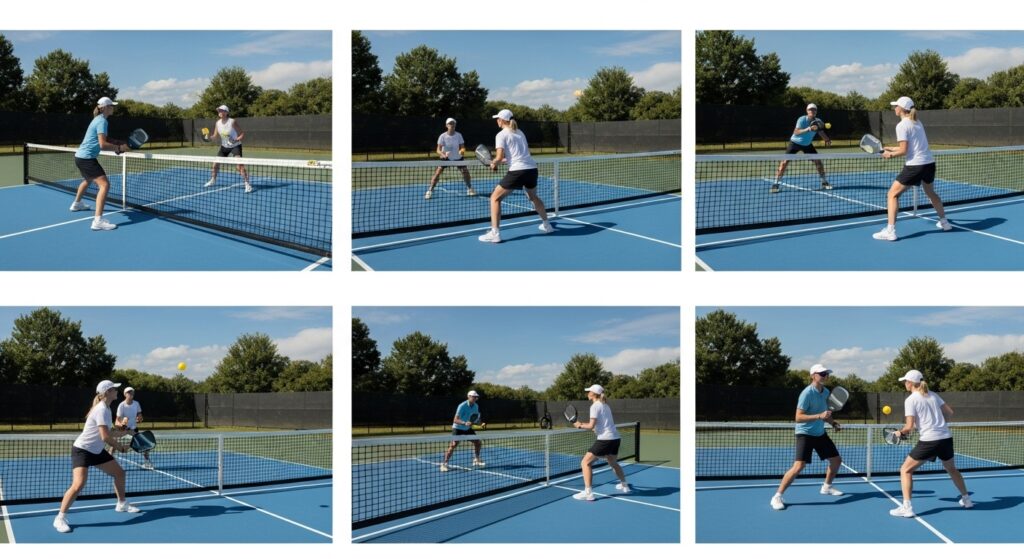
Using the Lob in Pickleball
The lob is a high, deep shot that travels over your opponent’s head and lands near their baseline. It can be used both offensively and defensively and is a fantastic tool for changing the dynamic of a point. Knowing how to hit a lob effectively can rescue you from a tough spot or win you the point outright.
Offensive vs. Defensive Lobs
- Offensive Lob: This is hit when your opponents are close to the kitchen line and you are in a balanced position. The goal is to catch them off guard and win the point immediately. It’s often disguised as a dink or a drive, making it hard to read.
- Defensive Lob: This is hit when you are out of position or off-balance, typically from the back of the court. The purpose is not necessarily to win the point, but to give yourself time to recover and get back into a neutral position. A good defensive lob is very high and deep.
Best Times to Lob
- When opponents are “camping” at the kitchen line: If your opponents are crowding the net, a well-placed lob can force them to scramble back.
- To change the pace: After a long dink rally, a sudden lob can surprise your opponents and break the rhythm.
- When you are pulled off the court: If your opponent hits a sharp angle that pulls you wide, a defensive lob can give you the time needed to get back to the middle.
- Against less mobile players: A deep lob can be very effective against players who have trouble moving backward quickly.
Common Lob Mistakes
- Hitting it too short: A short lob is the easiest shot in pickleball for your opponent to smash. Your lob must be deep enough to push them off the kitchen line.
- Hitting it too low: A low lob can be intercepted by a tall player with a good reach. Make sure your lob has enough height to clear their outstretched paddle.
- Overusing it: The lob is most effective when it’s a surprise. If you lob too often, good players will anticipate it and be ready to run it down.
Lob Drills for Accuracy
Have a partner stand at the kitchen line while you practice hitting lobs from your own kitchen line. Aim to make them take at least two steps back to return the ball. Then, have your partner hit shots that pull you wide and practice hitting defensive lobs to recover.
Paddle Grip & Holding Techniques
How you hold your paddle affects every shot you hit. While there is no single “correct” grip, understanding the different options and their pros and cons will help you find what works best for your style of play.
Eastern vs. Continental Grip
- Continental Grip (“Hammer Grip”): This is the most common grip in pickleball. To find it, imagine you are shaking hands with the paddle handle. The “V” formed by your thumb and index finger should be on top of the handle.
- Pros: It’s versatile. You can hit forehands, backhands, volleys, and dinks without changing your grip. This is crucial for the fast-paced exchanges at the net.
- Cons: It can be harder to generate heavy topspin on forehand drives.
- Eastern Grip (“Frying Pan Grip”): This grip is more common for players coming from a tennis background. Your palm is placed more directly behind the paddle handle.
- Pros: Excellent for hitting powerful forehand drives with topspin.
- Cons: It makes backhand shots, especially backhand volleys, more awkward. You often have to switch your grip for backhands, which can be too slow during a quick firefight.
For most players, especially beginners, the continental grip is the recommended starting point due to its versatility.
Finger on Paddle Edge – Pros/Cons
Some players find it comfortable to place their index finger on the edge of the paddle face.
- Pros: This can provide extra stability and control, particularly for dinks and volleys. It can give you a better feel for the paddle face angle.
- Cons: It may slightly reduce the power you can generate on drives and smashes, as it limits your wrist snap. It can also expose your finger to being hit by the ball.
Try it out during practice and see if it enhances your control without sacrificing too much power.
Adjusting Grip for Power vs. Control
You can make subtle adjustments to your grip pressure depending on the shot.
- For Control (Dinks, Drops): Use a light, relaxed grip. A “death grip” on the paddle will cause the ball to pop up. Think of your grip pressure as a 3 out of 10.
- For Power (Drives, Smashes): Tighten your grip just before impact to ensure the paddle is stable. Think of your grip pressure as a 7 or 8 out of 10 at the moment of contact.
Grip Size and Comfort Tips
Using the correct grip size is crucial for comfort and injury prevention. A grip that is too small can force you to squeeze too tightly, leading to tennis elbow. A grip that is too large can restrict your wrist movement. To find your size, you should be able to fit the index finger of your non-hitting hand in the space between your fingertips and the heel of your palm when gripping the paddle.
Singles vs. Doubles Strategy
The strategies for singles and doubles are vastly different. Doubles is a game of teamwork, patience, and kitchen control. Singles is a full-court sprint that emphasizes power, angles, and conditioning.
Court Coverage Differences
- Doubles: You are only responsible for one half of the court. The primary goal is to get to the non-volley zone line with your partner and control the net. Movement is mostly lateral and forward.
- Singles: You are responsible for the entire court. This makes it much more physically demanding. Court positioning and recovering to the center of the baseline after every shot are critical. The pickleball singles strategy is about creating open court space.
Shot Placement for Singles
- Serve and Return: The serve and return are the most important shots in singles. Serve deep to push your opponent back. Hit your return deep and to a corner to give yourself time to get to the net or recover to the center. A passing shot down the line or a sharp cross-court angle are your best friends.
- Attack the Open Court: The main goal in singles is to hit the ball where your opponent is not. Move them from side to side and force them to hit on the run.
Doubles Teamwork: Stacking, Communication, and Poaching
Pickleball strategy doubles is all about coordinated movement and communication.
- Communication: Constantly talk to your partner. Call “You!” or “Me!” on balls hit down the middle. Call out “Bounce it!” if a ball is going out. Announce when you are moving to cover a shot (“I’m moving!”).
- Movement: You and your partner should move as if connected by a string. When your partner moves to the sideline to hit a ball, you should shift toward the middle to cover the gap. When you are at the kitchen, move forward and backward together.
- Poaching: This is when a player at the net moves across the center line to intercept a ball intended for their partner. A well-timed poach can be an aggressive, point-ending move. It’s most effective when the opponent hits a weak or high return.
When to Attack vs. When to Defend
In both singles and doubles, you must know when to switch from defense to offense.
- Attack: You are on offense when you can hit the ball downward. This usually means your opponent has hit a high dink, a short return, or a weak lob.
- Defend/Reset: You are on defense when you are forced to hit the ball upward. This could be when you are retrieving a deep lob or dinking from the kitchen. In these situations, your goal is not to win the point, but to hit a neutral shot (like a dink or a third-shot drop) and reset the rally.
Advanced Pickleball Strategies
Once you have mastered the fundamentals, you can begin to incorporate advanced strategies that are common at the 4.0 level and above. These tactics are designed to create advantages and control the flow of the game.
Third-Shot Drop Explained (and Why It’s Crucial)
The third shot is the shot made by the serving team after the return of serve. Often, the serving team is stuck at the baseline while the returning team has already advanced to the kitchen line. The third shot drop is a soft shot that lands in the opponent’s kitchen, giving the serving team time to run up to their own kitchen line and neutralize the returning team’s advantage.
Without a reliable third-shot drop, you will often be forced to drive the ball, which can be easily blocked by opponents waiting at the net. It is arguably the most important shot for transitioning from defense to a neutral position.
Transitioning to the Net Effectively
Getting to the non-volley zone line is the primary objective in doubles. The journey from the baseline to the kitchen is called “transitioning.” You rarely want to sprint to the line in one go. Instead, use a split-step. As your opponent is about to hit the ball, take a small hop to land in a balanced, ready position. This allows you to react quickly to their shot, whether it’s a drive at your feet or a dink.
Offensive vs. Defensive Play Styles
- Offensive Player (“Banger”): These players look to end points quickly with hard drives and smashes. They thrive on pace and aggression. Their weakness is often a lack of patience, leading to unforced errors. To beat a banger, use soft shots like dinks and drops to take away their pace and force them to generate their own power.
- Defensive Player (“Pusher”/”Dinker”): These players are extremely consistent and patient. They win points by outlasting their opponents in long rallies and waiting for an error. Their weakness can be a lack of offensive weapons. To beat a defensive player, you must be aggressive but smart, looking for high balls to attack without getting impatient and making a mistake first.
Stacking Explained for Doubles Strategy
Stacking in pickleball doubles is an advanced positioning strategy used to keep players on their preferred sides of the court (e.g., keeping the player with the stronger forehand in the middle). In a normal game, your court position changes depending on the score. Stacking involves one or both players shifting their position either before the serve or before the return to ensure they end up on their desired side after the shot. It requires excellent communication and a deep understanding of the rules, but it’s a staple of high-level tournament play.
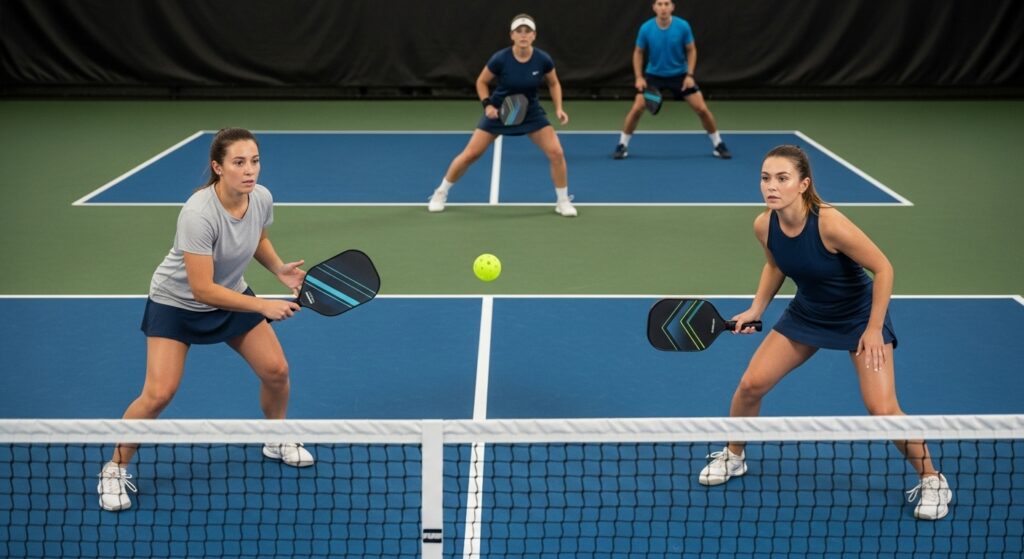
How to Win More Games
Winning consistently comes down to executing a smart game plan. It’s about more than just hitting good shots; it’s about hitting the right shots at the right time.
Anticipation and Reading Opponents
As you play more, you’ll learn to anticipate your opponent’s next shot. Watch their body language, paddle preparation, and court position. Do they always drive the ball when it’s on their forehand? Do they have a weak backhand? Exploiting these tendencies is key to winning strategies in pickleball. If you see your opponent taking a big backswing at the kitchen, they’re likely going to drive the ball, so get ready to block.
Shot Variety and Mixing Pace
Don’t be predictable. If you have been dinking for six shots in a row, surprise your opponent with a sudden speed-up or a lob. If you’ve been driving the ball hard, slow it down with a drop shot. Mixing up the pace and type of your shots keeps your opponents off-balance and prevents them from getting into a comfortable rhythm.
Positioning: Staying Out of “No Man’s Land”
“No man’s land” is the area of the court between the baseline and the non-volley zone line. Standing here is dangerous because balls hit at your feet are extremely difficult to return. After your serve or return, your goal should be to either get all the way to the kitchen line or stay back at the baseline. Avoid lingering in the middle of the court.
Mental Focus and Avoiding Frustration
Pickleball is a game of momentum. It’s easy to get frustrated after a few bad points, but letting that frustration affect your play will only lead to more errors. Take a deep breath between points. Focus on the next point, not the last one. A strong mental game is what separates good players from great players.
Also Read The Rise of Pickleball: How It Became the Fastest-Growing Sport ?
Common Beginner Mistakes
Every new player makes mistakes. Recognizing and fixing them is the first step toward improvement. Here are some of the most common pickleball mistakes:
- Overhitting the Ball: Beginners often use too much power, hitting the ball long or into the net. Focus on a controlled, compact swing. Let the paddle do the work.
- Standing Too Far Back from the Kitchen Line: Many new players are afraid of getting hit, so they stand a foot or two behind the kitchen line. This puts them at a disadvantage, as dinks will land at their feet. Get right up to the line so you can take volleys out of the air.
- Not Moving with Your Partner in Doubles: A common mistake is for one player to move to hit a shot while their partner remains stationary. This creates a huge gap in the court. Always move in tandem with your partner.
- Forgetting to Reset the Rally: When a beginner is on defense or out of position, their first instinct is often to hit the ball hard to try and win the point. This usually results in an error. The correct play is to hit a soft, un-attackable shot like a dink or a third-shot drop to reset the point and get back into position.
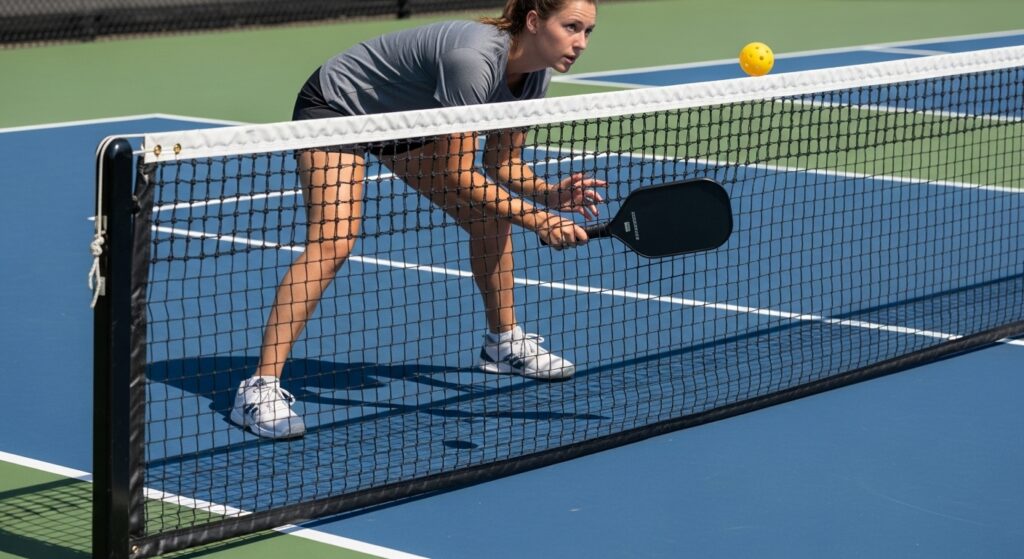
FAQs
How do you practice pickleball alone?
You can practice pickleball alone by using a wall or a rebounder net. Drilling against a wall is fantastic for improving reaction time and hand-eye coordination. You can also practice your serves on an empty court, aiming for specific targets to improve your accuracy and depth.
What’s the most important skill in pickleball?
While all skills are important, many advanced players would argue that the most crucial skill is the ability to hit a consistent, un-attackable “reset” shot (like a dink or a third-shot drop) when you are on defense. This skill allows you to stay in points you would otherwise lose.
Is pickleball more strategy or power?
Strategy almost always triumphs over power. A powerful player with no strategy will lose to a patient, strategic player who can neutralize their pace and wait for errors. The best players combine both, but strategy is the foundation.
How do you beat stronger players?
To beat players who are technically better or more powerful, you must play smarter. Keep the ball in play and make them hit one extra shot. Use soft shots to take away their pace. Identify their weaknesses (e.g., a weak backhand, poor mobility) and exploit them relentlessly. Play with high consistency and a strong mental game.
Conclusion
Improving your pickleball game is a rewarding process that blends physical skill with intellectual strategy. From mastering the serve and the third-shot drop to dominating the kitchen with patient dinks, every element of the game offers an opportunity for growth. Strategy is the key that unlocks your potential, allowing you to control the court, outsmart your opponents, and ultimately, win more games.
Whether you’re stepping onto the court for the first time or you’re a seasoned tournament player, remember to practice with purpose, play with patience, and never stop learning. The journey to becoming a better pickleball player starts now. Grab your paddle and start thinking about your next shot.
